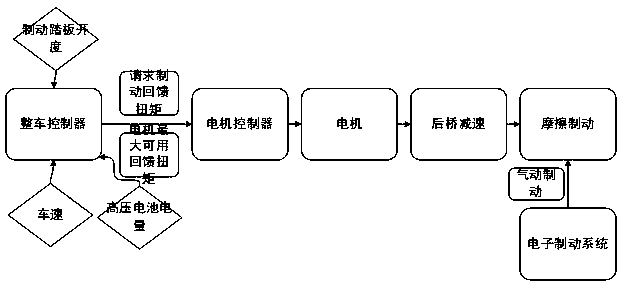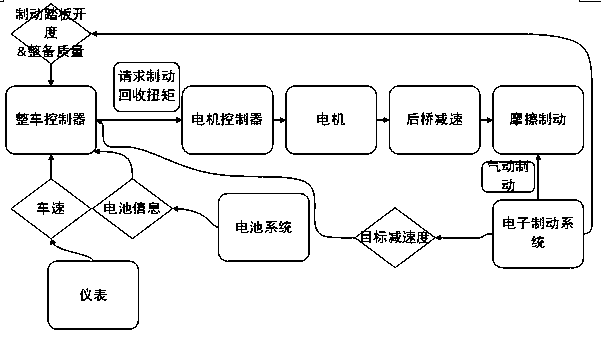Braking energy recovery control method for electric bus
A braking energy recovery and electric bus technology, which is applied to electric vehicles, electric braking systems, control drives, etc., can solve the problems of energy recovery decline, sacrifice of energy consumption economy, and passenger deceleration comfort, etc., to achieve flexibility The effect of large size, taking into account braking comfort, and a wide range of application scenarios
- Summary
- Abstract
- Description
- Claims
- Application Information
AI Technical Summary
Problems solved by technology
Method used
Image
Examples
Embodiment Construction
[0051] The present invention will be further described below in conjunction with the accompanying drawings and specific embodiments.
[0052] Please see attached figure 2 , a braking energy recovery control method for an electric bus, comprising the following steps:
[0053] Step 1: The vehicle control module 1 judges whether the electric bus enters the automatic energy recovery mode, if yes, executes step 2, if not, does not act.
[0054] The conditions for the electric bus to enter the automatic energy recovery mode are:
[0055] 1. The current gear of the electric bus is the forward gear.
[0056] 2. The battery management system 6 currently allows charging power>0.
[0057] 3. The current speed is ≥5 km / h.
[0058] 4. The accelerator pedal signal is invalid.
[0059] 5. The opening of the brake pedal switch is >0.05.
[0060] 6. The motor controller 2 detects that the torque lower limit of the motor is <0.
[0061] 7. The battery management system 6 detects that th...
PUM
 Login to View More
Login to View More Abstract
Description
Claims
Application Information
 Login to View More
Login to View More - R&D
- Intellectual Property
- Life Sciences
- Materials
- Tech Scout
- Unparalleled Data Quality
- Higher Quality Content
- 60% Fewer Hallucinations
Browse by: Latest US Patents, China's latest patents, Technical Efficacy Thesaurus, Application Domain, Technology Topic, Popular Technical Reports.
© 2025 PatSnap. All rights reserved.Legal|Privacy policy|Modern Slavery Act Transparency Statement|Sitemap|About US| Contact US: help@patsnap.com


